zur deutschen Version, Flagge klicken oder tippen

- Kingdom of Morocco
- constitutional monarchy
- own name: Al-Mamlakah al Maghribija
• Flags
• historical Flags
• Meaning/Origin of the Flag
• Coat of Arms
• Meaning/Origin of the Coat of Arms
• Aircraft Roundel
• Maps
• Numbers and Facts
• History
• Origin of the Country's Name
• The Republic of the Rif
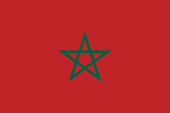
National flag,
ratio = 2:3,
Source, by: Flags of the World






Merchant flag,
ratio = 2:3,
Source, by: Flags of the World




Naval flag,
ratio = 2:3,
Source, by: Flags of the World



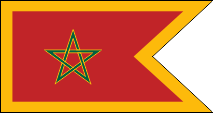
Naval jack,
Source, by: Flags of the World



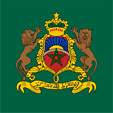
Standard of the Sultan,
Source, by: Flags of the World





16th cent. – 1915,
National flag,
Source, by: Flags of the World,
Flaggen aller Seefahrenden Nationen



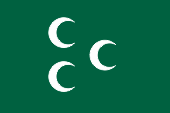
1810 – ca.1850,
meantime flag (doubtful)



French Morocco:

1915–1956
National flag,
ratio = 2:3,
Source, by: Flags of the World





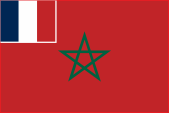
1923–1956,
Merchant flag,
ratio = 2:3,
Source, by: Flags of the World,
Wikipedia (EN)



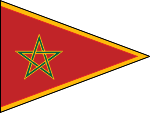
Standard of the Sultan,
Source, by: Flaggenbuch 1939



Spanish Morocco:

1915–1956,
National flag,
Source, by: Wikipedia (EN)



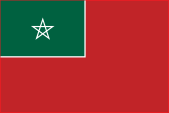
1937–1956,
Merchant flag,
ratio = 2:3,
Source, by: Flags of the World,
Wikipedia (EN)




Standard of the Calif,
Source, by: Flags of the World




1945–1956,
Flag of the Spanish High Commissioner,
Source, by: Die Welt im bunten Flaggenbild




The today's flag of Morocco was officially introduced on 17th of November in 1915 – initially only as flag for the army of the Sultan – by addition of the green pentagram in the middle of the red flag od the country. This should have been done by inducement of the French Marshal Lyautey to identify better the Moroccan troops as allies. But other sources mention Sultan Mulai Jussuf as initiator for the addition of the pentagram. About the origin or the meaning of the pentagram itself is nothing known except that it is a five-pointed variant of the Seal of Salomon. As Morocco became independent in 1956 this flag was maintained as national flag.
In the colonial time – between 1923 and 1956 – French-Morocco used the red flag with the pentagram completed by the French Tricolor in the upper staff quadrant as merchant flag. The merchant flag of Spanish-Morocco was introduced not until 1937. It was likewise single-coloured red, but had a green upper staff quadrant with the Seal of Salomo in white.
The colours of the flag seem to be defined today as follows: "Bright Red", which would correspond to Pantone 7620 and "Palm Green", which would correspond to Pantone 3425.
The flag of Morocco is already since more than 300 years a single-coloured red bunting. The colour red should symbolize the demand of the royal family for their descent from of prophet. The Alawite's Dynasty claims to descent over Fatima and Ali directly from the Prophet Mohammed. The sovereign carrys the honor-title Emir EI-Muminin "Leader of the Believers".
Red is even in the region of the Indian Ocean a flag color with a great tradition and wide dissemination, from the coasts of Arabia, over Zansibar to the Maldives, which stands in dense context to the islam. Red flags had and have all islamic dynasties, which come from the Alawites (Alides, descentants of Ali) like today Morokko or former North Yemen, the Arabian Emirates and Oman. Oman incorporated till 1730 the african eastern coast, to an in the today Mocambique. They moved their capital to Zansibar (1830) and founded a new empire which had its red flag, too.
Source: Flags of the World,
Die Welt der Flaggen,
Wikipedia (EN)

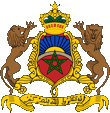
Coat of arms of Morocco,
Source, by: Corel Draw 4,
Jürgen Kaltschmitt

The present coat of arms of the state (actually coat of arms of the King) was introduced on 14th of August in 1957. It was created by the graphic artists Gauthier and Hainaut and shows a green pentagram on red infront of the Atlas Mountains and a rising sun. Above the royal crown. Two lions function as shield supporters. On a banner beneath the Arabic inscription: "If you help God, he will as well help you" (Koran, verse 7, sura 47).
Source: Flaggen Wappen Hymnen,
Flaggen und Wappen der Welt

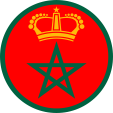
Aircraft roundel,
Source: Wikipedia (EN)

Aircraft roundel for naval aviation,
Source: Wikipedia (EN)

Position:
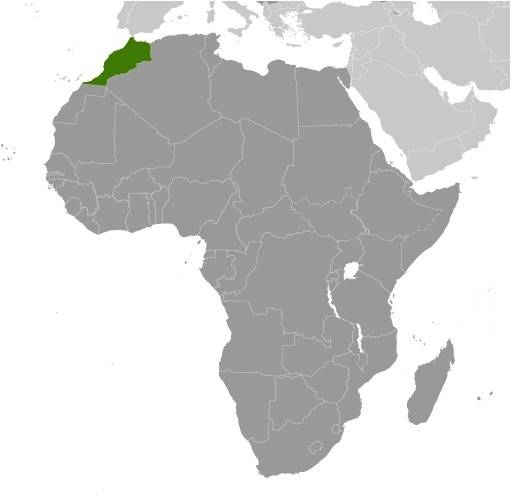
Source:
CIA World Factbook

Source:
CIA World Factbook

Area: 172.413 square miles, with Western Sahara (click here → Western Sahara): 275.116 sq.mi.
Inhabitants: 33.986.655 inh. (2017), with Western Sahara 34.589.908 inh., Structure: 44% Arabs, 45% Berbers, 10% Haratin (Black Africans), 1% Europeans
Density of Population: ca. 197 inh./sq.mi. (2017)
Religions: 98,7% Muslim, 0,1% Christian
Capital: Rabat (Er Rabât, Ar Ribat), 573.895 Ew. (2014)
official Language: Arabic
other Languages: Berber languages, French, Spanish
Currency: 1 Dirham (MAD) = 100 Centimes
Time Zone: GMT + 1 h
Source: Wikipedia (D)

42 A.D. · the on the territory of the today's Morocco situated Kingdom of Mauretania becomes as Mauretania Tingitana (Tingis = Tanger) province of the Roman Empire
395 · at the partition of the Roman Empire Mauretania comes to the West Roman Empire
429 · invasion of the Vandals from Spain, but those move on in direction of Tunisia, Mauretania remains in looser dependence from the Empire of the Vandals
533–534 · the Empire of the Vandals becomes conquered by the East Roman Empire (Byzantium), Mauretania becomes dependent from Byzantium
647–700 · subjection by the Arabic Califate, Islamization
986–1062 · reign of the Arabic dynasties of the Idrisides and the Fatimides
1062–1269 · reign of the Arabic dynasties of the Almoravides and Almohades (incl. Spain)
1269–1546 · reign of the Arabic dynasty of the Sherifes of Tafilâlt (descent from Ali, son-in-law of Mohammed)
1415 · conquest of Ceuta by the Portugese
1471 · conquest of Tanger by the Portugese
1497 · conquest of Melilla by the Spanish
1664 · establishment of the today's dynasty of the Alawite Sultans
1844 · military quarrels with France
1859–1860 · Spanish-Moroccan War, Spain occupys Tetouan
1904 · France starts the colonial development
1905 · First Morocco Crisis, the German Empire demands claims in Morocco
1911 · Second Morocco Crisis, the German Empire demands claims in Morocco again and sends the gunboat "Panther" → Panther Jump
1912 · France and Spain establish their protectorates in Morocco (Spain: a.) Oueddra Stripe in the south of Morocco, b.) Span. North Morocco – France: whole central Morocco), the German Empire recognizes the French protectorate in interchange with territories in Cameroon
1921–1926 · revolt of the Rif Kabyls under Abd el-Krim in Spanish Morocco, proklamation of the Republic of the Rif
1923 · Tanger becomes an international zone
1942 · in the Second World War debark allied troops in Morocco
1944 · foundation of the Istiklal Independence Party
1953 · the Sultan gets banished out of the country by France
1955 · the Sultan is allowed to return to Morocco
2nd of March 1956 · independence, with it annexion of formerly Spanish Morocco (but only Rif Area), Tanger becomes given back to Morocco
1957 · the Sultan nominates hisself to King Mohammed V.
1958 · Spain gives back the Oueddra Region to Marokko
1961 · the son of Mohammed V. becomes King of Morocco as Hassan II.
1962 · Morocco becomes constitutional monarchy
1963 · military quarrels with Algeria
1969 · Spain gives back to Morocco the enclave Ifni
1970 · first elections to parliament
1971 · attempted coup d'état of armed forces
1975 · Spain disclaims for its rights in West Sahara, the right of sovereignity of West Sahara becomes internationally recognized, Morocco and Mauritania invade West Sahara
1976 · Morocco and Mauritania partition West Sahara among themselves
1979 · Mauritania gives up its part of West Sahara for the West Sahara Liberation Front "POLISARIO", Morocco annexes this area too
1984 · Treaty of Oujda between Morocco and Libya to establish a Maghreb Union
1986 · Morocco terminates the Treaty of Oujda
1999 · death of Hassan II., his son becomes King as Mohammad VI.
Source: Atlas zur Geschichte,
Wikipedia (DE),
Discovery '97,
Weltgeschichte,
Länder der Erde

The (European) name "Morocco" derives drom the City of Marrakesh which was in the flowering period of the state in the middle ages the capital of the country (Empires of the Almoravides and Almohades). Ca. 1800 the country was still even named "Fés and Morocco". Fés was the other center of the country and even in several times capital. The Moroccans themselves name their state "Maghribija", so Maghreb – what means "West" – and what is the west of the Arabic world.
Source: Ronald Preuß

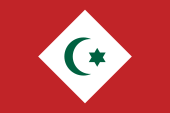
1921–1926,
Flag of the Republic of the Rif,
Source, by: Wikipedia (EN)



In 1920 there was an anti-Spanish uprising of the Riffians under Abd-al-Krim in Spanish Morocco with the aim of independence from Spain. The insurgents managed to occupy about 70% of the territory of Spanish Morocco. The Rif Republic was proclaimed on 18th of September in 1921. It had about 150.000 inhabitants and the capital was Ajdir. From 1925 the country was defeated by a Franco-Spanish army and defeated in May 1926.
Source: Wikipedia (DE)


Kindly supported by: E. Hoheisel (D), Jürgen Kaltschmitt (D)
![]()



















































